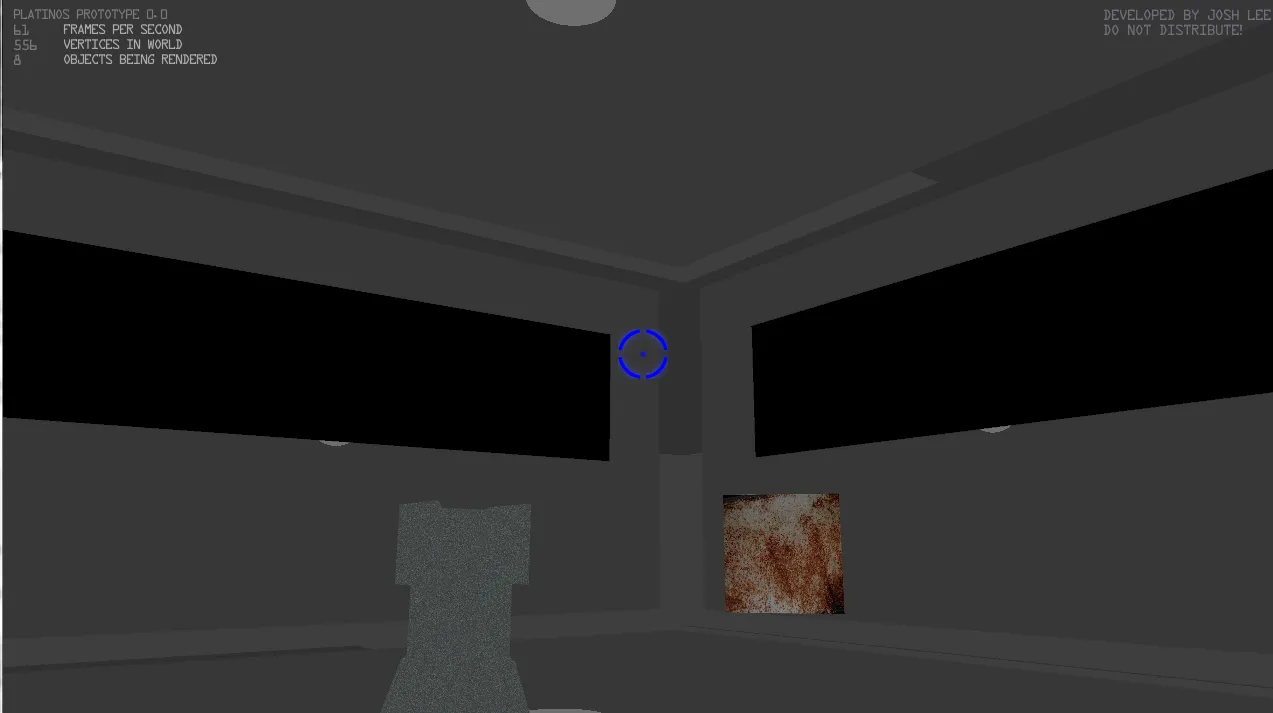我正在使用C++和OpenGL 3.2以及SFML开发一个3D游戏。我一直在努力实现点光源阴影映射,但是似乎我的做法符合我学到的和看到的示例,但仍然没有阴影。
我已经完成的工作是将我使用的所有代码按照精简的列表形式,按照使用顺序排列,而不是完整的源代码,只包含相关的代码(因为我的项目被分成了几个类):
我已经完成的工作是将我使用的所有代码按照精简的列表形式,按照使用顺序排列,而不是完整的源代码,只包含相关的代码(因为我的项目被分成了几个类):
Omnidirectional shadow mapping
C++
- Initialization
-- Use shadow pass shader program
-- Generate + bind the shadow frame buffer
glGenFramebuffers(1, &shadowFrameBuffer);
glBindFramebuffer(GL_FRAMEBUFFER, shadowFrameBuffer);
-- Generate a texture
glGenTextures(1, &shadowMap);
-- Bind texture as cubemap
glBindTexture(GL_TEXTURE_CUBE_MAP);
-- Set texture parameters
glTexParameteri(GL_TEXTURE_CUBE_MAP, GL_TEXTURE_WRAP_S, GL_CLAMP_TO_EDGE);
glTexParameteri(GL_TEXTURE_CUBE_MAP, GL_TEXTURE_WRAP_T, GL_CLAMP_TO_EDGE);
glTexParameteri(GL_TEXTURE_CUBE_MAP, GL_TEXTURE_WRAP_R, GL_CLAMP_TO_EDGE);
glTexParameteri(GL_TEXTURE_CUBE_MAP, GL_TEXTURE_MIN_FILTER, GL_LINEAR);
glTexParameteri(GL_TEXTURE_CUBE_MAP, GL_TEXTURE_MAG_FILTER, GL_LINEAR);
-- Generate empty 1024 x 1024 for every face of the cube
for (int face = 0; face < 6; face++)
glTexImage2D(GL_TEXTURE_CUBE_MAP_POSITIVE_X + face, 0, GL_DEPTH_COMPONENT32F , 1024, 1024, 0, GL_DEPTH_COMPONENT, GL_FLOAT, NULL);
-- Attach the cubemap to the framebuffer
glFramebufferTexture(GL_FRAMEBUFFER, GL_DEPTH_ATTACHMENT, shadowMap, 0);
-- Only draw depth to framebuffer
glDrawBuffer(GL_NONE);
- Every frame
-- Clear screen
glClearColor(0.0f, 0.0f, 0.0f, 1.0f);
glClear(GL_COLOR_BUFFER_BIT | GL_DEPTH_BUFFER_BIT);
-- Render shadow map
--- Bind shadow frame buffer
glBindFramebuffer(GL_FRAMEBUFFER, shadowFrameBuffer);
--- Set the viewport to the size of the shadow map
glViewport(0, 0, 1024, 1024);
-- Cull front faces
glCullFace(GL_FRONT);
-- Use shadow mapping program
--- Define projection matrix for rendering each face
glm::mat4 depthProjectionMatrix = glm::perspective(90.0f, 1.0f, 1.0f, 10.0f);
--- Define view matrices for all six faces
std::vector<glm::mat4> depthViewMatrices;
depthViewMatrices.push_back(glm::lookAt(lightInvDir, glm::vec3(1,0,0), glm::vec3(0,-1,0) )); // +X
depthViewMatrices.push_back(glm::lookAt(lightInvDir, glm::vec3(-1,0,0), glm::vec3(0,1,0) )); // -X
depthViewMatrices.push_back(glm::lookAt(lightInvDir, glm::vec3(0,1,0), glm::vec3(0,0,1) )); // +Y
depthViewMatrices.push_back(glm::lookAt(lightInvDir, glm::vec3(0,-1,0), glm::vec3(0,0,-1) )); // -Y
depthViewMatrices.push_back(glm::lookAt(lightInvDir, glm::vec3(0,0,1), glm::vec3(0,-1,0) )); // +Z
depthViewMatrices.push_back(glm::lookAt(lightInvDir, glm::vec3(0,0,-1), glm::vec3(0,1,0) )); // -Z
--- For every object in the scene
---- Bind the VBO of the object
---- Define the model matrix for the object based on its position and orientation
---- For all six sides of the cube
----- Set the correct side to render to
glFramebufferTexture2D(GL_FRAMEBUFFER, GL_DEPTH_ATTACHMENT, GL_TEXTURE_CUBE_MAP_POSITIVE_X + i, shadowMap, 0);
----- Clear depth buffer
glClear(GL_DEPTH_BUFFER_BIT);
----- Send model, view and projection matrices to shadow mapping shader
glUniformMatrix4fv(glGetUniformLocation(shadowMapper, "lightModelMatrix"), 1, GL_FALSE, glm::value_ptr(depthModelMatrix));
glUniformMatrix4fv(glGetUniformLocation(shadowMapper, "lightViewMatrix"), 1, GL_FALSE, glm::value_ptr(depthViewMatrices[i]));
glUniformMatrix4fv(glGetUniformLocation(shadowMapper, "lightProjectionMatrix"), 1, GL_FALSE, glm::value_ptr(depthProjectionMatrix));
----- Draw the object
glDrawElements(....);
- END SHADOW MAP DRAW
-- Cull back faces
glCullFace(GL_BACK);
-- Use standard shader program
-- Bind default framebuffer
glBindFramebuffer(GL_FRAMEBUFFER, 0);
-- Activate cubemap texture
glActiveTexture(GL_TEXTURE1);
-- Bind cubemap texture
glBindTexture(GL_TEXTURE_CUBE_MAP, shadowMap);
-- Tell shader to use first texture
glUniform1i(glGetUniformLocation(currentProgram->id, "shadowmap"), 1);
-- Send standard MVPs and draw objects
glDrawElements(...);
- END C++
=================================
GLSL
shadowpass vertex shader source
#version 150
in vec3 position;
out vec3 worldPosition;
uniform mat4 lightModelMatrix;
uniform mat4 lightViewMatrix;
uniform mat4 lightProjectionMatrix;
void main()
{
gl_Position = lightProjectionMatrix * lightViewMatrix * lightModelMatrix * vec4(position, 1.0);
worldPosition = (lightModelMatrix * vec4(position, 1.0)).xyz; // Send world position of vertex to fragment shader
}
shadowpass fragment shader source
#version 150
in vec3 worldPosition; // Vertex position in world space
out float distance; // Distance from vertex position to light position
vec3 lightWorldPosition = vec3(0.0, 0.0, 0.0); // Light position in world space
void main()
{
distance = length(worldPosition - lightWorldPosition); // Distance from point to light
// Distance will be written to the cubemap
}
standard vertex shader source
#version 150
in vec3 position;
in vec3 normal;
in vec2 texcoord;
uniform mat4 modelMatrix;
uniform mat4 viewMatrix;
uniform mat4 projectionMatrix;
out vec3 fragnormal;
out vec3 fragnormaldirection;
out vec2 fragtexcoord;
out vec4 fragposition;
out vec4 fragshadowcoord;
void main()
{
fragposition = vec4(position, 1.0); // Position of vertex in object space
fragtexcoord = texcoord;
fragnormaldirection = normalize(modelInverseTranspose * normal);
fragnormal = normalize(normal);
gl_Position = projectionMatrix * viewMatrix * modelMatrix * vec4(position, 1.0);
}
standard fragment shader source
#version 150
out vec4 outColour;
in vec3 fragnormaldirection;
in vec2 fragtexcoord;
in vec3 fragnormal;
in vec4 fragposition;
uniform mat4 modelMatrix;
uniform mat4 viewMatrix;
uniform mat4 projectionMatrix;
uniform mat4 viewMatrixInversed;
uniform sampler2D tex;
uniform samplerCube shadowmap;
void main()
{
vec3 lightpos = vec3(0.0, 0.0, 0.0);
vec3 pointToLight = (fragposition * modelMatrix).xyz - lightpos; // Get vector between this point and the light
float dist = texture(shadowmap, pointToLight).x; // Get distance written in texture
float shadowfactor = 1.0;
if (length(pointToLight) > dist) // Is it occluded?
shadowfactor = 0.5;
outColour = texture(tex, fragtexcoord) * shadowfactor;
}
以下是我的代码所做的事情的图片:

这是一种奇怪的效果,但似乎接近我想要的效果。看起来0,0,0处暴露在光线下的任何表面都会有一个中心无阴影的圆形,而其他所有表面则没有阴影。